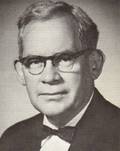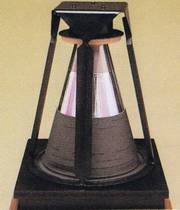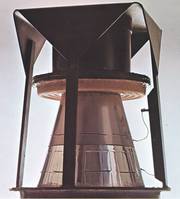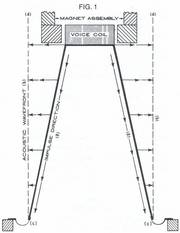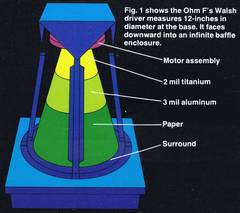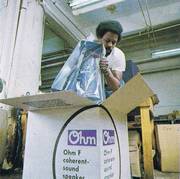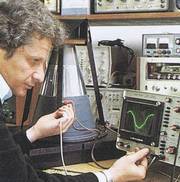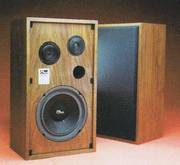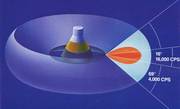Ich nehme den englischen Ohm Prospekt von 1977
und extrahiere die wenigen Seiten über die Theorie dieses Systems. Das ist meist in Englisch, doch neben dran gibt es den deutschen Testbericht von vor ganz langer Zeit.
Etwa 2005 in einem amerikanischen Text gefunden:
Lincoln Walsh died before his speaker was released to the public. After developing the Ohm A prototype, in 1973 Ohm introduced the Ohm F speaker to critical acclaim. The Ohm F could reproduce audio signals more accurately than any other speaker, and had a truly spectacular sound. (Thirty years later, the Ohm F still sounds better than many of today’s most expensive, most exotic speaker designs.) Unfortunately, the Ohm F was also a very expensive. All the way back in 1982 they cost $4,000 per pair !
.
The Ohm F Walsh loudspeaker stands alone . . . .
The OHM F is a product of many years of scientific investigation into the behavior of loudspeaker cones. This patented design is unlike any other loudspeaker.
The OHM F employs a single steeply sloped 12" driver, which faces downward into a tapered infinite baffle enclosure. This enclosure is available finished in your choice of walnut, teak, or rosewood veneers. The single driver with full 360° horizontal dispersion, reproduces all audible frequencies without time or phase distortion. This is coherent sound. No multidriver loudspeaker system is capable of it.
- Anmerkung : Das stimmte damals bereits nicht, es gab und es gibt 1977 bereits mehrere 360° Rundstrahler.
As a result of this coherence, listening to an OHM F you hear the music, not the loudspeaker.
The Coherent-Sound Loudspeaker:
A Radical Innovation by Ohm
A totally new class of loudspeakers was born when Ohm Acoustics announced the original Ohm A prototype in 1972. The design principle was so radically new, it was not even mentioned in the most up-to-date textbooks on electroacoustics.
Invented by the now legendary Lincoln Walsh (1903-1971) and further refined by Marty Gersten at Ohm Acoustics (exclusive licensee of Walsh's U.S. Patent 3,424,873) the coherent-sound loudspeaker owes more to antenna theory than to traditional speaker design.
While loudspeaker cones were supposed to be acting like rigid pistons, Walsh's simple experiments proved that paper cones actually behaved like poor transmission lines. Walsh decided to make use of this fact to build a better loudspeaker.
The Great Piston Fallacy
The general acceptance of the rigid piston as a model for a loudspeaker cone can be attributed to the traditional emphasis placed on frequency response as a criterion forjudging loudspeakers — to the exclusion of other equally important criteria.
By using several "pistons" of different sizes and constructions (woofer, mid-range, and tweeter) in conjunction with a frequency-dividing (crossover) network, it
has been possible to achieve a fairly uniform frequency response across the audio range, in more or less limited directions. This has helped keep the piston myth alive.
However, while such an arrangement of pistons can indeed produce a relatively even frequency response, it will invariably have non-linear phase and time characteristics — the importance of which will be discussed later.
To qualify as a true piston, the entire speaker cone would have to move as a perfectly rigid body when pushed at its apex by the voice coil. To qualify as a high fidelity piston, the cone would ave to move at exactly the same time and velocity as the voice coil; that is, it would have to be without any inertia.
Unfortunately, this means that a high fidelity cone piston must simultaneously be infinitely stiff, yet weigh nothing — a classic reduction to absurdity.
What is Coherent-Sound?
The acoustic output of the transmission-line cone described above is the same as would be produced by a cylinder pulsating radially, with every portion on its surface moving in simultaneously and out simultaneously, in perfect phase with the input audio signal. This kind of output is called "coherent-sound" since it is analogous to coherent light as produced by a laser.
More and more authorities are beginning to admit that phase response is every bit as important in a high fidelity speaker as frequency response. Without phase coherence, an instrument's fundamentals and harmonics could still be reproduced with flat frequency (or amplitude) response, but would not arrive together at the listener's ears. This is known as "time delay" distortion. Such reproduction sounds vaguely unnatural, without any definite sense of what is "wrong". "Ohm coherent-sound loudspeakers are virtually free of this sort of distortion."
Anmerkung:
Das haben übrigens auch die Entwickler bei Braun, Heco und Canton herausgefunden, daß die Hoch- Mittel- und Tieftöner senkrecht übereinander stehen sollten (müssten), um das Frequenzspektrum gleichphasig abzustrahlen. Eine der ersten Boxen dieser Art war die "Canton Ergo Aktiv" Box.
-
How it Works
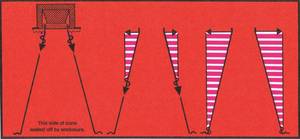
- Fig. 2 shows how a Walsh speaker achieves coherent sound. As the supersonic wave travels down the cone, all the horizontal waves produced in the air meet on the vertical line Standing on the surround. Thus a cylindrical wave front, with virtually no phase or time errors, is generated. It is a coherent wave-front, which appears to be generated by a virtual pulsating diaphragm, standing on the surround of the actual transmission-line cone.
How the Walsh speakers achieve coherent sound is shown in Figure 2.
There is no woofer, midrange, or tweeter. A single electro-dynamic driver covers the entire audio range. It is mounted face down on top of its enclosure with the magnet up and the convex side of the cone radiating into the listening area.
The cone itself (which resembles a dunce cap) is very steep arid made largely of titanium and aluminum foil to achieve great stiffness. It acts as a high loss wave transmission line along which a sound wave moves at more than 3000 feet per second, which is in excess of 21/2 times the speed of sound in air.
The waves are generated at the apex of the cone by an electrodynamic transducer consisting of a very powerful Alnico V-7 magnet and an unusually sophisticated 3-inch voice coil which has been granted U.S. Patent 3,935,402.
It consists of a rectangular aluminum ribbon which is edge-wound on the long edge into a very compact, rigid coil. Rather than having a plastic or enamel coating on it, the aluminum wire we use has an indestructible anodized coating. The finished coil assembly can operate at temperatures so high, you can melt lead on it, and it still won't fail!
While the voice coil is designed to handle large amounts of amplifier power with ease, its mass is only 4 grams — about the same as a small electrostatic panel. In accordance with the mathematics of a cone acting as a wave transmission line, the mass of the voice coil represents the total inertia of the moving system at the highest frequencies.
The waves travel down the side of the cone to the surround, by which time they have been absorbed. There is virtually no reflection back into the cone; the transmission line is properly terminated by various mechanical techniques so that each impulse traverses the slant distance of 12 3/8 inches from the apex to the surround essentially once only.
In exactly the same amount of time, waves generated in the air at the apex travel horizontally a distance of 3 1/8 inches to a point directly above the surround. The geometry of the cone is calculated to maintain this exact relationship between the supersonic slant wave and the sonic horizontal wave.
By examining Figure 2, you can see that, as the supersonic wave travels down the cone, all the horizontal waves produced in the air meet on the vertical dotted line standing on the surround. Thus, a cylindrical wave front is generated which has virtually no time or phase errors. It is a coherent wave front, which appears to be generated by a virtually pulsating diaphragm of cylindrical shape, standing on the surround of the actual transmission-line cone.
Conventional speakers ?
All conventional speaker cone designs are therefore compromises between sufficient stiffness to get "piston action", and low enough mass for "transient response".
Conventional speaker cones are imperfect devices that can be expected to cause colorations of the audio signal — expecially when several different sizes of cones are combined in a single speaker system to achieve flat frequency response.
A far more accurate conceptual model of the ideal speaker, according to Walsh, is a conical surface that conducts "ripples" in the organized and predictable manner of a terminated wave transmission line. A more familiar example of such a "high fidelity transmission line" is the "twin-lead" that carries 82 TV channels from the antenna to your TV set.
In addition to the previously described phase coherency of such a wave front, the design has the further advantage of omnidirectional radiation with reflective gimmicks. A 360 degree doughnut-shaped dispersion pattern is produced directly off the diaphragm! (See Figure 3)
The Ohm F does not suffer from standing wave problems. It does not suffer from phase response problems. It does not suffer from frequency response problems. And it is the only cone-type loudspeaker that will accurately reproduce any complex wave form!
Lincoln Walsh's insight was a major one in that it advanced the state-of-the-art (for once, the term is not used frivolously) at both ends — in performance and in simplicity.
The acoustic output of the speakers is the closest approximation of the physicist's theoretical ideal — a "pulsating sphere" — that has been achieved so far. At the same time, the design uses only a single cone diaphragm and voice coil, eliminating the need for multiple drivers as well as crossover networks. In a technology that unhesitantingly creates complexity to accompany "progress", such a double break-through is truly remarkable.
Reports:
.
- "It may well be the finest speaker on the market and is certainly without a doubt among the top few."
The Complete Buyer's Guide to Stereo/Hi-Fi Equipment/1977 - "The OHM F system is amongst the very best we have heard."
Austrailian Hi-FiStereo Buyer's Guide/1975 - "Ohm Acoustics Corp. has achieved an exceptional development. One is tempted to say that the weakest link is no longer the speaker but the recording!"
Radio TV Electronic 10 (Published in Switzerland) October 1975 - "The Ohm F's are in a class by themselves. The sound is most unusual inasmuch as it is complete, full, natural and transparent. The bass reproduction is clean and perfect."
Hi-Fi Stereo (Published in Germany) October/1974 - "In our stimulated live-vs-recorded test it rated A to A4. The sound began to warrant the use of such words as 'awesome'. The low bass, too, was extraordinarily clean and powerful. The Ohm F achieves state-of-the-art performance."
Stereo Review/November 1973 - "They have one great quality, a quality which puts them right in the front line of desirable speakers. They sound musical. What comes out is music."
The FM Guide/December 1976 (Published in Canada)
.

